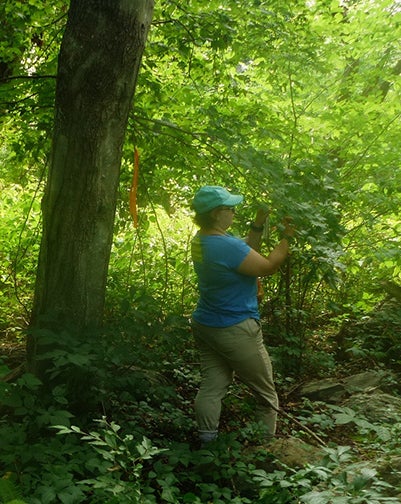KINGSTON, R.I. – July 26, 2016 — The University of Rhode Island and the Rhode Island Natural History Survey have been awarded a grant of $183,700 from the Wildlife Conservation Society’s Climate Adaptation Fund for a demonstration project designed to improve habitat for birds in Middletown by making it more resilient to the effects of climate change.
The two-year project at the Norman Bird Sanctuary and Sachuest Point National Wildlife Refuge involves the removal of invasive plants and replacing them with native species in areas where natural plant cover has been damaged.
“We’re taking an area that is already globally important bird habitat and manipulating it to make sure it retains that function into the future,” said David Gregg, executive director of the Natural History Survey. “Rising sea levels will literally shorten the distance between coastal features like the salt marsh and the adjacent coastal forest. And whereas we’ve sometimes treated them separately in the past, I hope this project will help all involved see them as connected and interdependent.”
URI ecologist Scott McWilliams, a professor of natural resources science, and doctoral student Clara Cooper-Mullin are conducting bird surveys of the sites before and after the vegetation restoration to determine the success of the project. They will also train staff at the sanctuary to continue the surveys after the project has been completed.
“Birds are sensitive indicators of environmental change,” said McWilliams. “If you want to track the effects of climate change on the coastal environment, birds are a good sentinel.”
Pre-restoration surveys of the birds at the sanctuary found a good variety of typical species found in wetland, forest and coastal scrub habitats, including yellow warblers, gray catbirds and eastern towhees, as well as less common species like yellow-billed cuckoos and orchard orioles.
“I did counts at eight locations around the sanctuary for three weeks in a row beginning at the end of May,” Cooper-Mullin said. “I’ll repeat the surveys next year so we can look at how the restoration affects the birds in the future.”
Volunteers and staff of the Natural History Survey are now working to remove privet and other invasive plants and propagating native plant species for installing later this summer.
“We hope to do more than adapt the physical landscape to climate change,” said Natasha Harrison, executive director of the Norman Bird Sanctuary. “The rich human history of this area is part of its value and we want people in the community to feel a connection to the land as climate change takes place.”
Walks and demonstrations will be held throughout the duration of the project targeting the general public, as well as land managers and ecological restoration practitioners who can apply lessons learned through this project to other projects to improve climate resilience.
The project leverages work already under way to raise the height of the salt marsh along the Maidford River above the level of projected sea level rise. The nearby coastal forest at Norman Bird Sanctuary works together with the marsh to provide important shelter for nesting and migratory birds.
“Recent studies show that in coming years, sea level rise will push the marsh into the lower reaches of the forest, changing both over time and straining their ability to support bird populations,” said Gregg. “In addition to the vegetation work, we’ll also be investigating various strategies for reducing the damage hungry deer do to the plants in the forest understory.”

